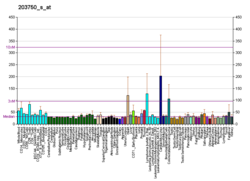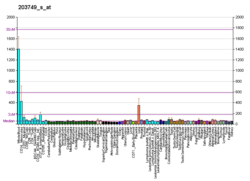Retinoic acid receptor alpha
Protein found in humans From Wikipedia, the free encyclopedia
Retinoic acid receptor alpha (RAR-α), also known as NR1B1 (nuclear receptor subfamily 1, group B, member 1), is a nuclear receptor that in humans is encoded by the RARA gene.[5][6]
NR1B1 is a gene with a protein product and has a chromosomal location of 17q21.2. RARA codes for the nuclear hormone receptor retinoic acid receptor, alpha subtype, a transcription factor. There are another two subtypes of RARs: beta and gamma subtypes.[7][8]
Function
Retinoid signaling is transduced by two families of nuclear receptors, retinoic acid receptor (RAR) and retinoid X receptor (RXR), which form RXR/RAR heterodimers. In the absence of ligand, DNA-bound RXR/RARA represses transcription by recruiting the corepressors NCOR1, SMRT (NCOR2), and histone deacetylase. When ligand binds to the complex, it induces a conformational change allowing the recruitment of coactivators, histone acetyltransferases, and the basic transcription machinery.[9]
Retinoic acid receptor-alpha, the protein, interacts with retinoic acid, a derivative of vitamin A, which plays an important role in cell growth, differentiation, and the formation of organs in embryonic development.[8][10]
Once retinoic acid binds to the RAR, the heterodimer initiates transcription and allows for its target genes to be expressed. [10]
Clinical significance
RA signaling has been correlated with several signaling pathways in early embryonic development. First, it participates in the formation of the embryonic axis, which establishes symmetry in the offspring. RA also influences neural differentiation by regulating the expression of pro-neural induction factor Neurogenin 2 (Neurog2). RA affects cardiogenesis, as it plays a role specifically in the formation of the atrial chambers of the heart. RA also plays a role in the development of the pancreas, kidneys, lungs, and extremities. [10]
Translocations that always involve rearrangement of the RARA gene are a cardinal feature of acute promyelocytic leukemia (APL; MIM 612376). The most frequent translocation is t(15,17)(q21;q22), which fuses the RARA gene with the PML gene.[11]
Acute promyeloid leukemia
Summarize
Perspective
RARA plays an important role in the establishment of the immune system by inducing T-regulatory cells, promoting tolerance, and controlling the differentiation of immature immune cells in the bone marrow called promyelocytes into mature white blood cells.[12] The prevalence of this gene in the developing immune system leaves it subject to possible defects, the most common of which is a condition known as acute promyeloid leukemia (APL), caused by a somatic mutation described by the fusion of RARA and the PML gene located on chromosome 15.[13] This fusion results in the formation of the protein complex PML-RARα. Under normal circumstances, PML produces a tumor suppressing protein that works by inhibiting uncontrolled rapid cell growth. When the two proteins fuse together, their normal functions are hindered, resulting in the accumulation of promyelocytes in the bone marrow unable to differentiate past this immature phase.[13] This fusion makes up for the cause of 98% of APL cases, with some other rare mutations and fusions making up the other 2%.6 Current treatment approaches include all-trans-retinoic acid (ATRA) which works by targeting and degrading the PML-RARα protein complex, in addition to chemotherapy and platelet transfusions.[14]
Interactions
Retinoic acid receptor alpha has been shown to interact with:
Genetic studies
Knock-out mice studies showed that a deletion in one of the copies of the RARA gene did not create any observable defect, while deletion of both copies shows symptoms similar to that of vitamin A deficiency. This proved that all three subtypes of RARs work redundantly.[citation needed]
Ligands
- Antagonists
- BMS-189453 (non selective)
- YCT529 (selective for RAR-α)
See also
References
Further reading
Wikiwand - on
Seamless Wikipedia browsing. On steroids.








